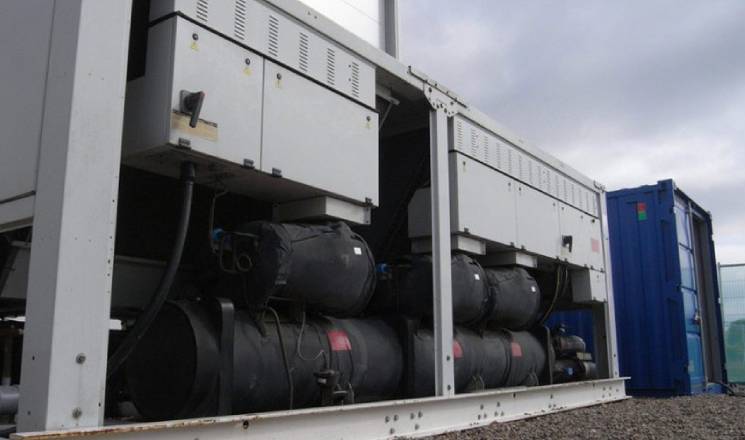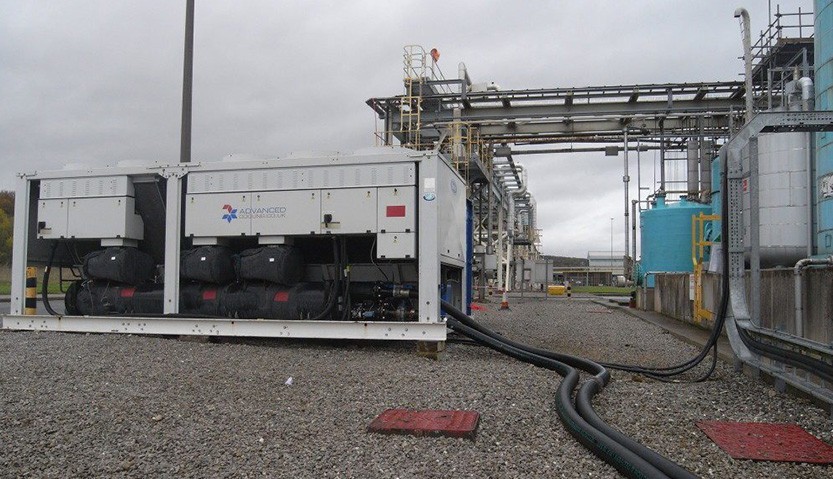Chiller units are machines that cool mediums such as water or air using a vapour compression process with refrigerant to move energy.
Chiller Units

Chiller units are machines that cool mediums such as water or air using a vapour compression process with refrigerant to move energy.

The basic physical rules of a refrigeration process remain the same, however the mechanical devices used to achieve this differ.
Pretty much all chiller units cool (remove energy) using what is called the vapor compression cycle.
The vapor compression cycle is a thermodynamic cycle used in most refrigeration and air conditioning systems. It is the primary cycle responsible for the cooling in chiller units. This cycle consists of four main components: a condenser, an expansion valve, an evaporator and compressor.
Below is a brief overview of this cycle and how it works
Initially, the process starts with a compressor, which compresses low-pressure, low-temperature refrigerant vapor, typically a HFC (Hydrofluorocarbon) or other refrigerant. The compressor increases pressure a temperature of the refrigerant.
The high-pressure, high-temperature refrigerant then enters the condenser, where it exchanges heat to the surroundings and changes state from a high-pressure vapor to a high-pressure liquid. At this point it leaves the condenser as a solid liquid column.
This high-pressure liquid refrigerant then passes through a device known as an expansion valve, where it undergoes a drop in pressure. At this point the refrigerant expands rapidly, effectively boiling, leading to a decrease in temperature and pressure inside the evaporator.
Inside the evaporator the refrigerant is changing state from a liquid to a vapor, in effect boiling-off. This requires energy in the same way as a kettle boiling water generating steam requires electrical energy. In an evaporator, the refrigerant absorbs this energy from the surroundings (air or water) and boils/ evaporates, changing from a low-pressure liquid to a low-pressure vapor.
This cycle then repeats as the vaporised refrigerant returns to the compressor and starts the process again. The overall effect being, that energy is removed from the medium, water or air, which consequently has a cooling effect.
Chiller units are used for all sorts of cooling applications from food stuffs and other perishables, to process’s and spaces, otherwise commonly known as air conditioning.
Chiller units are used to control chemical and other manufacturing processes to make them safe or to improve efficiencies. Generally, chillers cool water which is then supplied to the work place. In this instance, water is used as a secondary refrigerant.
Cooling systems play a critical role in the production, storage and logistics of foods. Often called the “cold chain” perishable foods are produced, stored and transported in a continuous temperature controlled environment which maintains quality and extends life.

Chiller units in larger applications are used to cool water which is subsequently pumped around a building to air handling units where it chills air. The chilled air is then used to cool the space.
Refrigeration is used to cool products to a holding temperature. Predominantly used in the food industries it plays a critical role in ensuring food quality at the outset.
In a nutshell, cooling plays a big part in all our everyday lives. Mostly behind the scenes, it plays a critical part in modern industries, including, food supply chains, ensuring that fresh products are delivered to us in the best condition.
Temporary chiller units are used in pretty much the same way as fixed systems- the basic principles are the same. The main differences lie in the functionality of equipment used, which is designed to be portable and modular so as to fit into different scenarios without requiring re-manufacture.
Chiller units are stored and maintained in readiness for supply to project along with all ancillary equipment including hose, fittings and cabling.
Depending on the application, they may be supplied with other equipment to cool spaces or processes, such as, air handling units for space cooling, or pumps and water heat exchangers for industrial processes.
Chillers are at the heart of what we do at Advanced Climate Rentals. Maintaining a diverse fleet capable of excelling in all scenarios is critical to our core business.
The type of unit we will supply depends directly on the application. Theres really no substitute in terms of building a reliable and efficient temporary system.
We use flexible rubber pipe-work systems to connect our chillers to our customers plant or other equipment that we supply, such as, AHU’s and heat exchangers. Its a really great system that can be fitted and modified quickly, whilst having all the features that you would expect of a permanent system.
We think you will be surprised at whats possible, so please get in touch to find out. Learn more about temporary chiller hire here